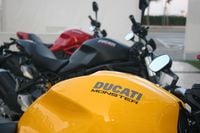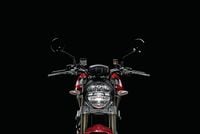In 1992, Ducati was a relatively small manufacturer known for its competent, though somewhat unconventional, sporting motorcycles. At the time, posters of the 916 were yet to adorn the bedroom walls of a generation of teenagers, Carl Fogarty had not yet given the marque four world championships, and the Desmosedici’s first MotoGP race was still a decade away. In September of that year, Ducati introduced the M900 at the Cologne Motor Show, unveiling a new design ethos that was culturally modish and quintessentially Italian. It would be perhaps more significant to the future direction of the marque than even its greatest racebikes. The machine was nicknamed “The Monster” because of its Frankenstein assemblage of parts: an air-cooled Desmodue engine from a 900 Supersport, a modified trellis frame from the 851/888 superbike, and an inverted fork from a 750 Supersport. The Monster, with more upright ergos reminiscent of the 750 GT from decades earlier, was a Ducati designed for the streets, not for the racetrack.
The Monster was penned by Miguel Galluzzi, the Argentinian designer who is also responsible for the looks of the iconic Ducati 900SS of the '90s (he's the current head of design at the Piaggio Advanced Design Center). Many credit the Monster as being the first "naked bike," a somewhat dubious distinction given that performance motorcycles had been unfaired for decades. Still, in 1992, Ducati's model range comprised only sportbikes, so the Monster is at least responsible for taking the company in a new direction in the Cagiva era and beyond.
In the 1996 book The Ducati Story, Ian Falloon says, “While the Monster has been undoubtedly successful in the short time it has been in production, it remains to be seen how long its appeal will last. Previous Ducatis that haven’t had a totally sporting focus have always suffered falling sales after a couple years.”
What Falloon couldn’t have predicted at the time was that the Monster would pave the way for modern Ducatis to be something other than superbikes. These days, Ducatis are power cruisers, ADV bikes, scramblers, and motards. Ducati has sold roughly 323,000 Monsters worldwide.



/cloudfront-us-east-1.images.arcpublishing.com/octane/IN263JIBTBCD3O265IMSCW6OZM.jpg)
/cloudfront-us-east-1.images.arcpublishing.com/octane/SMAQ354X2JH7NJATXNSQY4NRS4.jpg)
/cloudfront-us-east-1.images.arcpublishing.com/octane/GGOH2AQRSVHY5C5JLNEVYLB5SU.jpg)
/cloudfront-us-east-1.images.arcpublishing.com/octane/TJJEHV3ATZFFXHUYZABHXKE2DI.jpg)
/cloudfront-us-east-1.images.arcpublishing.com/octane/WIC4RXQ36BAXNIW6U4UJ3XDLKI.jpg)
/cloudfront-us-east-1.images.arcpublishing.com/octane/B4PQZLY4LBHITGE5ZRRM2N5YNU.jpg)
/cloudfront-us-east-1.images.arcpublishing.com/octane/OBYS7KWZUJFCHD44YPTSVM5EF4.jpg)
/cloudfront-us-east-1.images.arcpublishing.com/octane/FY7ZXYBT4NH2NGYQIWQVITS4AM.jpg)
/cloudfront-us-east-1.images.arcpublishing.com/octane/JPET6WQUDZEYLNXVY5LRNDRPLA.jpg)
/cloudfront-us-east-1.images.arcpublishing.com/octane/EY6P2QIFQJCDTNOMR3JB7WJED4.jpg)
/cloudfront-us-east-1.images.arcpublishing.com/octane/V2U6JB7KXNCQRN4OW6HNJTVMZQ.jpg)
/cloudfront-us-east-1.images.arcpublishing.com/octane/AMS43BT5ABH77NY7XKLCSZCNM4.jpg)
/cloudfront-us-east-1.images.arcpublishing.com/octane/NTK2ASYKUBDW5MQDWQLVQYOELY.jpg)
/cloudfront-us-east-1.images.arcpublishing.com/octane/SX7R3KCIANGDBGF45O73F543TM.jpg)
/cloudfront-us-east-1.images.arcpublishing.com/octane/ZTW4V7RAPFG6RFWJRXR2IX5ZQ4.jpg)
/cloudfront-us-east-1.images.arcpublishing.com/octane/EPRSLPIUTBC5RPD7R263BPV2D4.jpg)
/cloudfront-us-east-1.images.arcpublishing.com/octane/EMJ4I2T4HVCRVJPZ3UJFVMRDHA.jpg)
/cloudfront-us-east-1.images.arcpublishing.com/octane/CBDAM3VMJNFDBLE7Y3FY7RD5BY.jpg)
/cloudfront-us-east-1.images.arcpublishing.com/octane/CCEB3TNMU5FH3OZ4FKJ7DA2LBA.jpg)
/cloudfront-us-east-1.images.arcpublishing.com/octane/VV6N3KUWEVFJJD7F7VX6ICOH7Q.jpg)
/cloudfront-us-east-1.images.arcpublishing.com/octane/R55SVEXZ5VA2LCWFWYR647ASX4.jpg)
/cloudfront-us-east-1.images.arcpublishing.com/octane/MYWIEFOQ6JCCNDR4OBF5PU5LVE.jpg)
/cloudfront-us-east-1.images.arcpublishing.com/octane/OOZ3C4GCUJGRNONDI6DHVM57GI.jpg)
/cloudfront-us-east-1.images.arcpublishing.com/octane/JEKB3CMWXZD6ZAVFEDKLOQ5FNY.jpg)